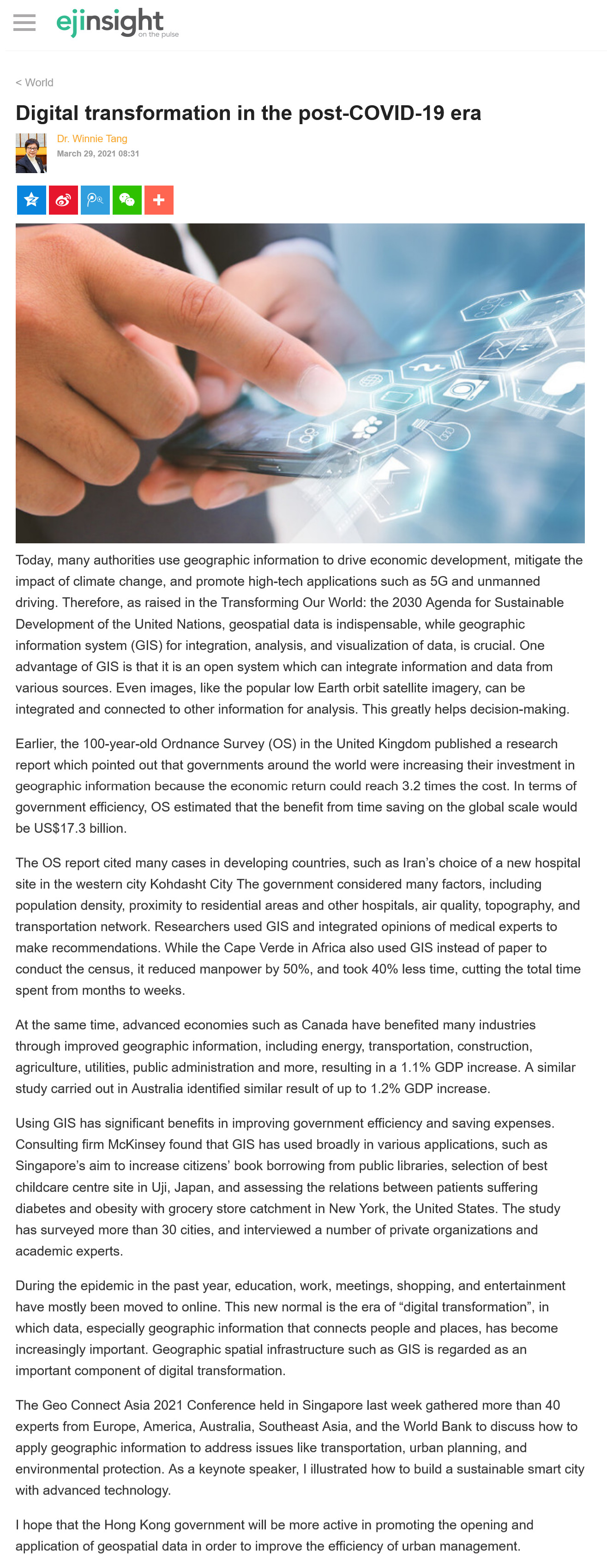網上版請按此

Digital transformation in the post-COVID-19 era
Today, many authorities use geographic information to drive economic development, mitigate the impact of climate change, and promote high-tech applications such as 5G and unmanned driving. Therefore, as raised in the Transforming Our World: the 2030 Agenda for Sustainable Development of the United Nations, geospatial data is indispensable, while geographic information system (GIS) for integration, analysis, and visualization of data, is crucial. One advantage of GIS is that it is an open system which can integrate information and data from various sources. Even images, like the popular low Earth orbit satellite imagery, can be integrated and connected to other information for analysis. This greatly helps decision-making.
Earlier, the 100-year-old Ordnance Survey (OS) in the United Kingdom published a research report which pointed out that governments around the world were increasing their investment in geographic information because the economic return could reach 3.2 times the cost. In terms of government efficiency, OS estimated that the benefit from time saving on the global scale would be US$17.3 billion.
The OS report cited many cases in developing countries, such as Iran’s choice of a new hospital site in the western city Kohdasht City The government considered many factors, including population density, proximity to residential areas and other hospitals, air quality, topography, and transportation network. Researchers used GIS and integrated opinions of medical experts to make recommendations. While the Cape Verde in Africa also used GIS instead of paper to conduct the census, it reduced manpower by 50%, and took 40% less time, cutting the total time spent from months to weeks.
At the same time, advanced economies such as Canada have benefited many industries through improved geographic information, including energy, transportation, construction, agriculture, utilities, public administration and more, resulting in a 1.1% GDP increase. A similar study carried out in Australia identified similar result of up to 1.2% GDP increase.
Using GIS has significant benefits in improving government efficiency and saving expenses. Consulting firm McKinsey found that GIS has used broadly in various applications, such as Singapore’s aim to increase citizens’ book borrowing from public libraries, selection of best childcare centre site in Uji, Japan, and assessing the relations between patients suffering diabetes and obesity with grocery store catchment in New York, the United States. The study has surveyed more than 30 cities, and interviewed a number of private organizations and academic experts.
During the epidemic in the past year, education, work, meetings, shopping, and entertainment have mostly been moved to online. This new normal is the era of “digital transformation”, in which data, especially geographic information that connects people and places, has become increasingly important. Geographic spatial infrastructure such as GIS is regarded as an important component of digital transformation.
The Geo Connect Asia 2021 Conference held in Singapore last week gathered more than 40 experts from Europe, America, Australia, Southeast Asia, and the World Bank to discuss how to apply geographic information to address issues like transportation, urban planning, and environmental protection. As a keynote speaker, I illustrated how to build a sustainable smart city with advanced technology.
I hope that the Hong Kong government will be more active in promoting the opening and application of geospatial data in order to improve the efficiency of urban management.
Dr. Winnie Tang
Adjunct Professor, Department of Computer Science, Faculty of Engineering; Department of Geography, Faculty of Social Sciences; and Faculty of Architecture, The University of Hong Kong